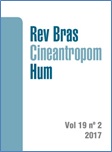Association between school structure and physical activity in physical education class and school recess
DOI:
https://doi.org/10.1590/1980-0037.2017v19n2p164Abstract
The aim of this study was to verify the association between the characteristics of the school structure and the physical activity of students in the physical education class and school recess. This is an association study with quantitative approach. The random sample is composed of 176 schoolchildren (71 boys and 105 girls) from 10 schools of the city of Passo Fundo-RS, Brazil. Physical activity was evaluated with a pedometer, after which the average number of steps in the physical education class and school recess was calculated. The characteristics of the school structure were evaluated by direct observation, with the audit tool in the school. Data were analyzed using descriptive statistics, independent t-test and generalized linear regression. The mean number of steps among boys was higher when compared to girls in the physical education class (t=3.478, p<0.001, d cohen=0.62) and in the school recess (t=2.537, p<0.01; d cohen=0.45). The number of steps in physical education class was not associated with the characteristics of the school structure. In the school recess, an inverse association was found, where boys enrolled in schools with regular quality structure performed on average 208.04 (95%CI=16.44/399.65; p=0.03) steps when compared to boys enrolled in schools with good quality structure. Schools that have bigger and/or better structure do not necessarily influence adolescents in the practice of physical activity in school recess and physical education classes.



